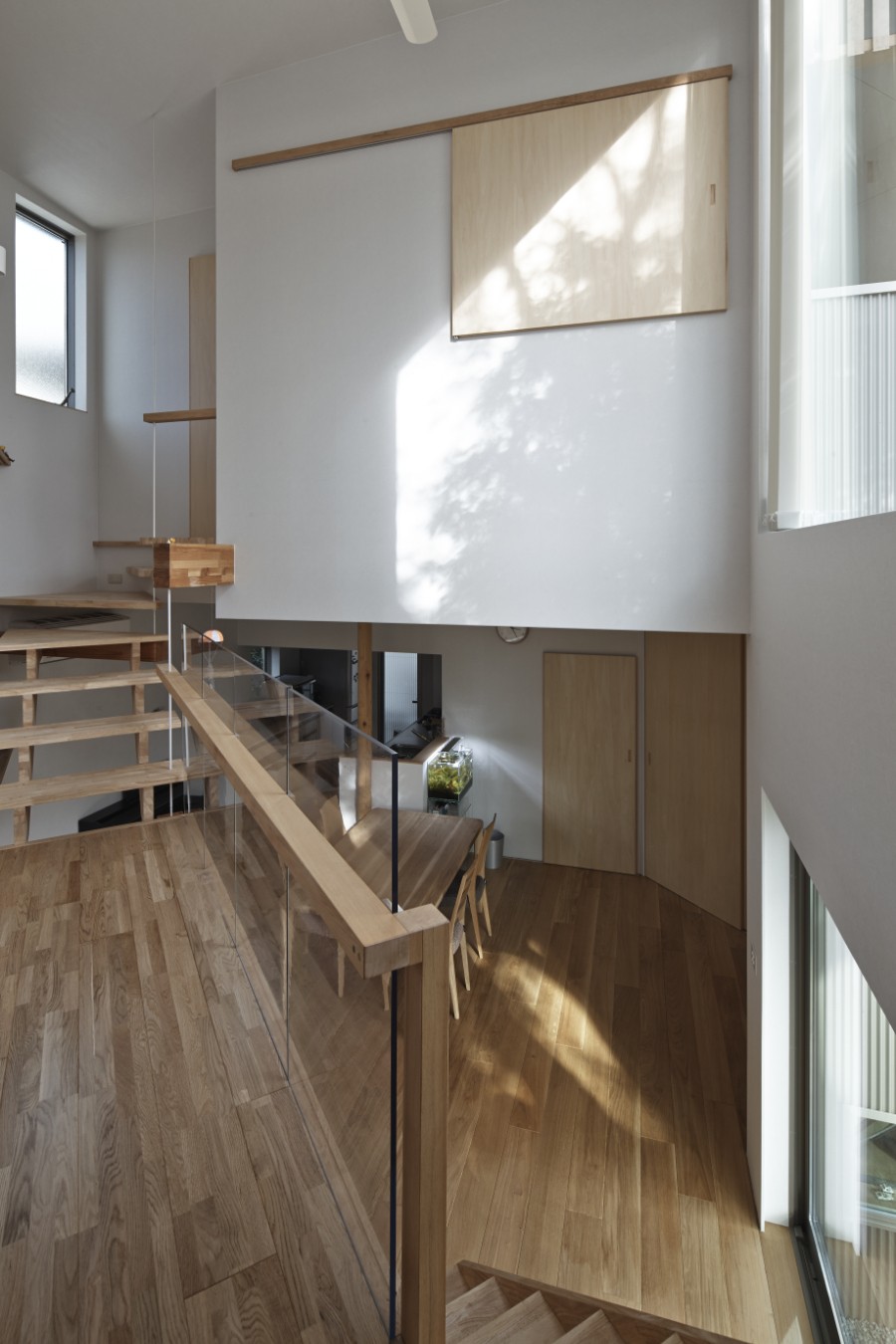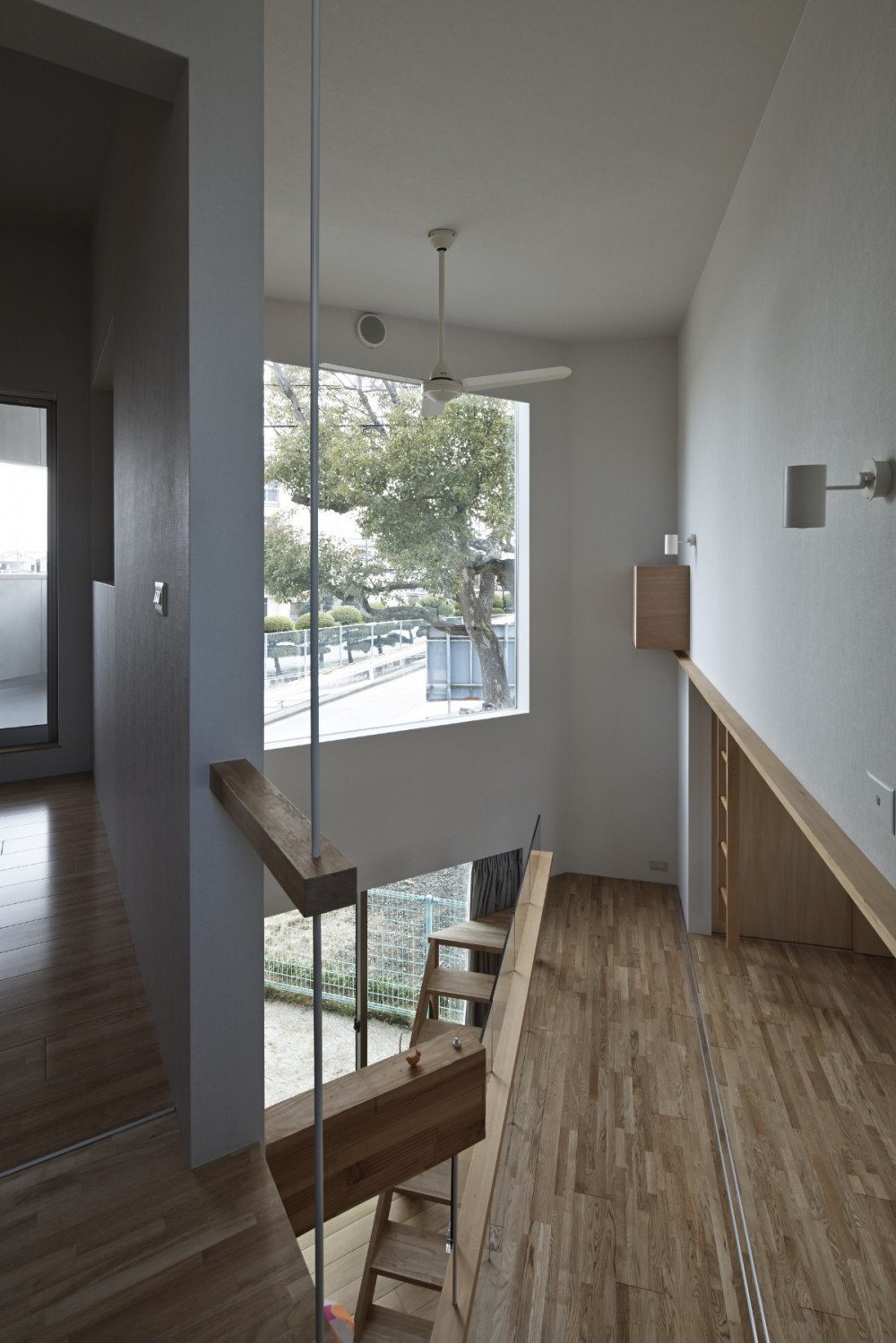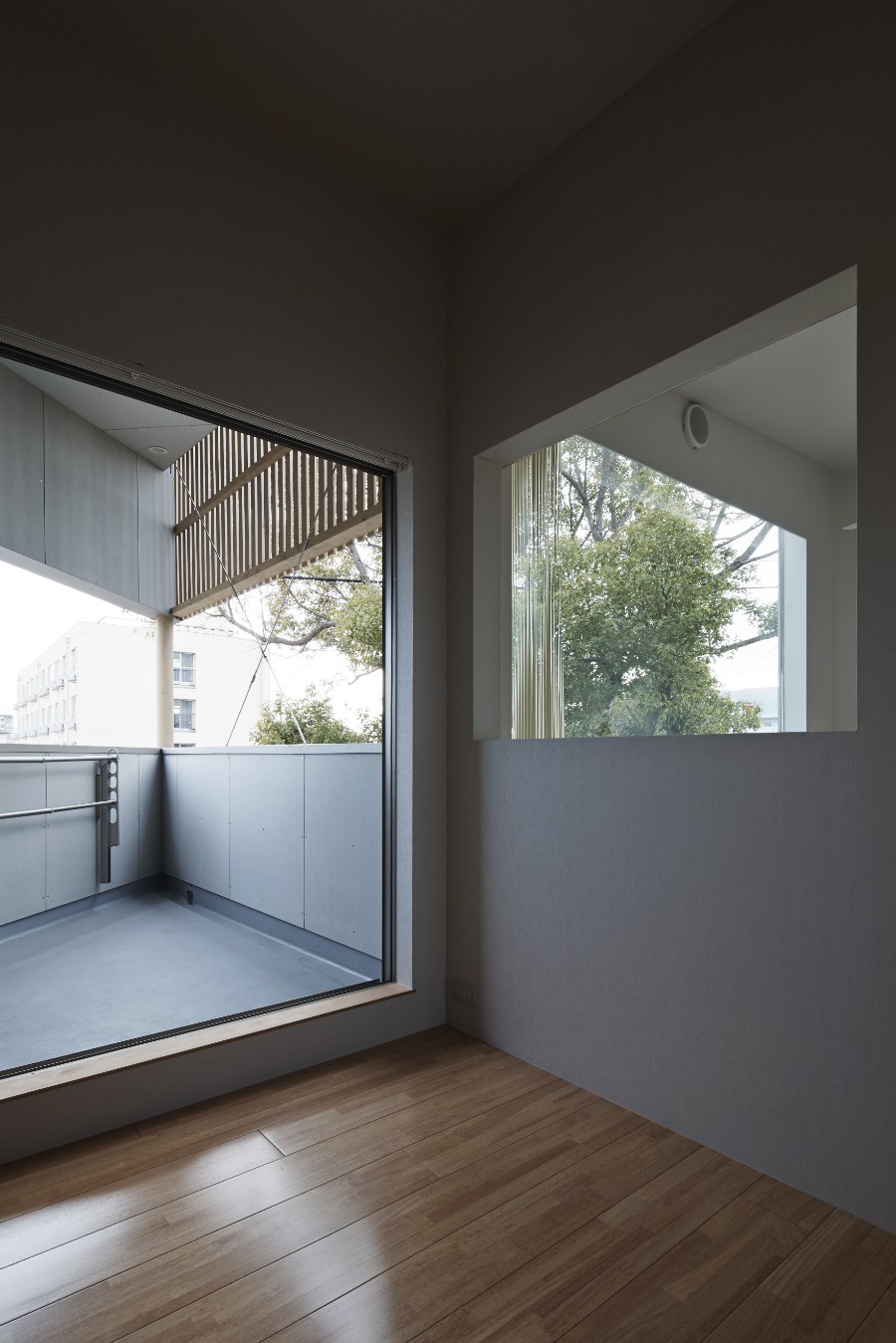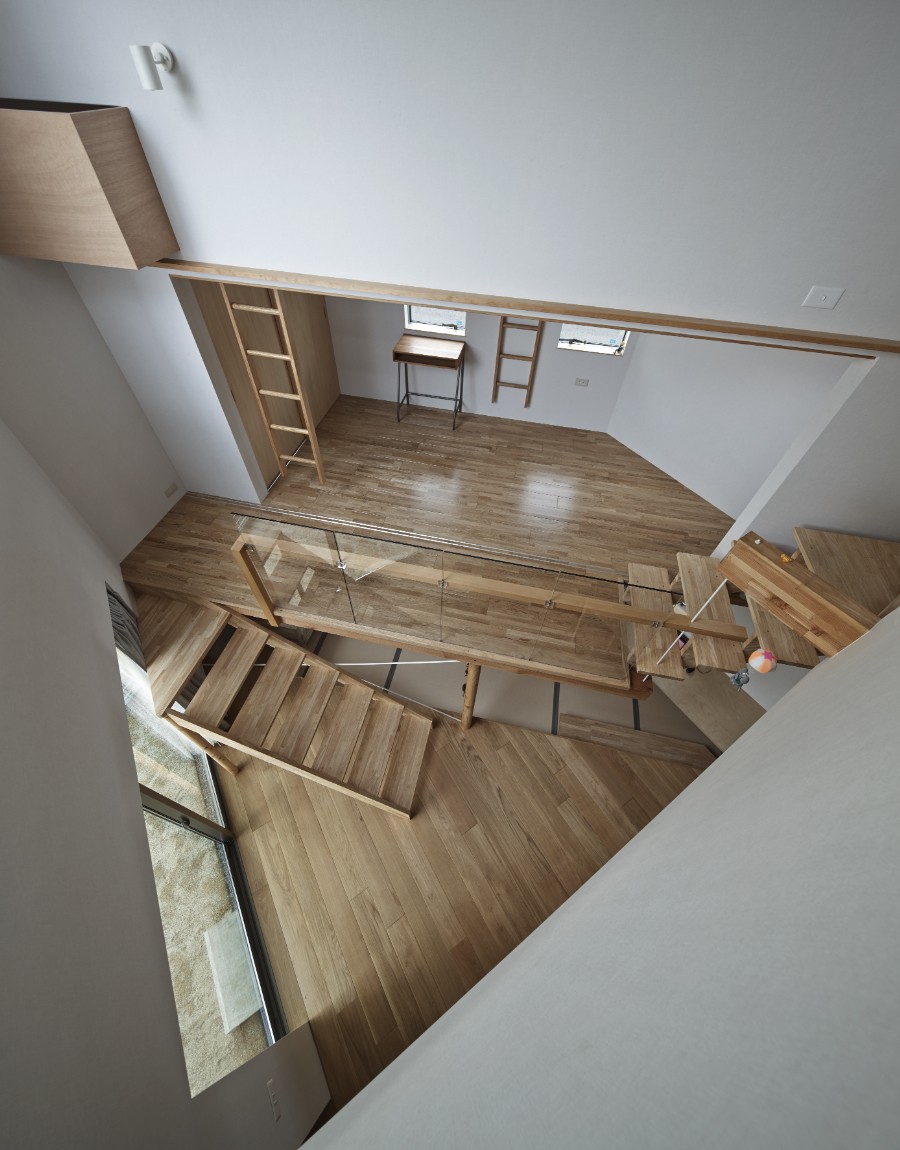
The house is built facing the trees in a small adjacent park like vacant lot. It has a triangular hollow garden facing the trees. On the other side of the park, there is a road at a level raised by about 1 meter, beyond which is a river.

View from the dining room and kitchen through the atrium toward the tatami living room space and the children’s space on the 1.5F.

Looking up around the triangular atrium in the center of the LDK. From the children’s space on the upper 1.5F on the left, access to the 2nd floor living room on the right is via the back staircase.
Looking up the triangular stairwell in the center of the LDK.
From the children’s space on the upper left 1.5F, access to the 2nd floor living room on the right through the back staircase.
The second floor living room is reinforced with a suspension structure from the top to prevent pillars from falling into the dining space on the lower floor.

Tatami living space with floor seating with a ceiling height of 1,800 mm. It is placed a little lower from the road on the left and the dining space on the right.
Tatami living space with a ceiling height of 1,800㎜. The adjacent land outside the window on the left is 1m above the road. To avoid overlooking from the road, the floor level of the tatami is lowered and the window is placed between the road and the guardrail, so that people walking on the road do not cross their line of sight. The floor is lowered 360㎜ from the dining space on the right. The low ceiling and lowered floor lower the center of gravity and make the space a calm and relaxing place.

View of the stairwell from the 1.5-floor hallway. An interior window is mounted on the front second floor facing the stairwell. Below that is the dining space.

View of the triangular stairwell from the 1.5-floor hallway. The large FIX window at the upper right hand side and the sliding sliding sweep window below it. The second floor balcony can be seen at the top through the window.
The large window and the sliding glass window face due south, allowing pleasant light to enter the stairwell and fill the room with light. Vertical blinds were installed on the upper FIX windows to control the light depending on the time of day.
On the left is the staircase leading from the 1.5F to the second-floor bedroom and the balcony beyond.

Children’s space on 1.5F. Although a small space, it can be used as one with the hallway facing the stairwell and is spacious. The ceiling is high with a loft bed above.
View of the children’s space on the 1.5F from the hallway. The hanging wall between the hallway and the children’s space can be used as a private room with sliding partition doors when the children grow up in the future.
Although the area of the children’s space is small, the ceiling above the space is high, and the bed is placed above the loft space.

Loft bed in a child’s room. The width is a little narrow, but the ceiling height can be secured in the children’s space.
Loft bed in the children’s room. Due to the site and the overall area, the width of the children’s room is a little narrow at about 1800mm, but instead, the bed space is set up in the loft so that the ceiling can be secured at a higher height. The 2200mm-long loft bed, which allows for ample sleeping space, is placed slightly protruding above the corridor.
Another loft in the children’s room. The beam in the foreground is a beam to support a wall for dividing the room into two children’s rooms in the future.

Looking toward the stairwell from the stairs leading to the second floor. The bedrooms are to the east, and the hallway in front of the children’s room is at the lower right. The large window in the front of the house overlooks a kusunoki tree in the park.


Looking down the triangular stairwell from the second floor bedroom. The 1.5 floor kids’ space facing the stairwell can be seen.

Built in a small park like a vacant lot, set back from the trees, yet recessed toward the trees.
The house is set back from the trees in a small park that looks like a vacant lot, yet is set back from the trees. The large window on the left side of the hollow faces due south, and the trees to the southwest provide shade from the western sun.
Architects Type
The site is located at the junction of the natural topography created by the curve of the river and the man-made city block divided by an orthogonal grid. The site is a deformed lot that has existed as a blank space for a long time, connected to a small open space-like park with a large camphor tree. The couple who found the site and their children who will be born and raised there.
The plan follows a 45° intersecting grid to fit the deformed site, the garden is triangularly concave toward the trees, and the atrium is triangularly vaulted. The three responses to the natural topography are: 1) to make effective use of the site area, 2) to create a moderate separation and connection between the trees and the park while allowing the south-facing light to shine through, and 3) to provide a children’s room on the 1.5 floor that will be used as a kids’ space for a while, while the tatami space on the lower floor is located on the 1.5 floor within sight of the first floor, with a window to block the view from the adjacent road. 3) To provide a children’s room on the 1.5F that can be used as a children’s space for a while, while allowing the folding space on the lower floor to have windows and a ceiling height that can be overlooked from the adjacent road.
The result is a one-room house with various spaces of different sizes and shapes. The large atrium, which looks like a park and trees outside, and familiar small rooms, such as furniture and storage, create a chain reaction that neutralizes the usual spatial framework of “exterior/architecture/room/furniture,” which is divided according to meaning and size. The oblique directionality of the building’s design is multidirectional to the body’s senses, and I believe it has created a space where one can feel a sense of freedom.
When I was looking at the completed building, I was reminded of a scene from “My Neighbor Totoro” in which a tree expands and grows in stages. Watching the movie again for the first time in more than 20 years, I saw a dream scene in which Satsuki, Mei, and Totoro grow nuts into a large tree through a strange ritual, a physical and spatial form, as if the life force of children and nature were in harmony. Totoro floats as a chain of small, medium, and large scale steps, and Totoro’s dwelling place is a large camphor tree. I remember that during the design process, I was communicating with the client mainly via LINE e-mail, and the client’s LINE icon was an image of Mei from “Totoro. What was the connection and how did it affect the plan?
The reason for building the house and the client’s request
The client was referred to us as a design firm that specializes in creating floor plans for deformed lots, and although another firm had initially drawn a floor plan for a small pentagonal deformed lot, it did not seem to fit well because of the constraints imposed by the deformed topography, such as the size of the house and the way the rooms are connected to each other.
The client wanted to make the most of the site, and to have a large open space in the vertical direction, as well as the number and type of rooms necessary.

